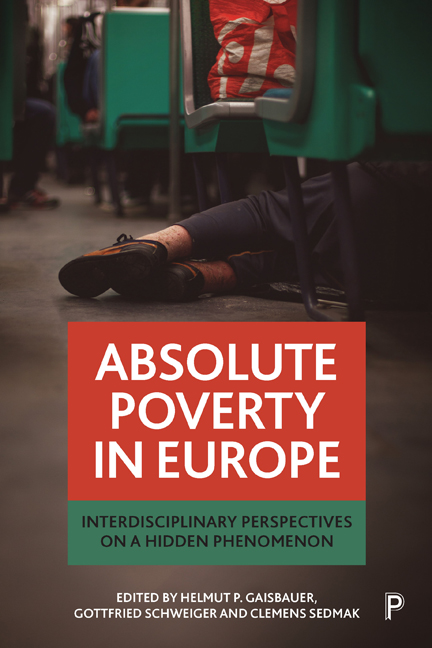Book contents
- Frontmatter
- Contents
- List of figures and tables
- Notes on contributors
- 1 Absolute poverty in Europe: introduction
- Part One Conceptual and methodological challenges
- Part Two Key issues for the absolute poor
- Part Three Policy responses to absolute poverty in Europe
- Part Four Ethical perspectives on absolute poverty in Europe
- Conclusion responding to the dark reality of absolute poverty in European welfare states
- Index
1 - Absolute poverty in Europe: introduction
Published online by Cambridge University Press: 27 April 2022
- Frontmatter
- Contents
- List of figures and tables
- Notes on contributors
- 1 Absolute poverty in Europe: introduction
- Part One Conceptual and methodological challenges
- Part Two Key issues for the absolute poor
- Part Three Policy responses to absolute poverty in Europe
- Part Four Ethical perspectives on absolute poverty in Europe
- Conclusion responding to the dark reality of absolute poverty in European welfare states
- Index
Summary
Goal 1 of the Sustainable Development Goals (SDG), the successor of the controversial Millennium Development Goals (MDG), is to end poverty in all its forms everywhere. That formulation is certainly progress over past political agendas and the MDGs because it acknowledges that poverty in all its forms and wherever it is to be found poses a huge social, cultural, political and economic challenge (Fukuda-Parr 2016; Schweiger 2016). It also moves on from a focus on poverty in developing countries and is truly global in its perspective, including Europe as a whole as well as the richest European countries such as Germany, France, the UK, Sweden and the Netherlands. Furthermore, the SDG leave room for debates about the methods and concepts in poverty research, which are needed to grasp poverty in all its forms, and explicitly acknowledges that poverty is multidimensional and to be found in different forms and manifestations.
Poverty in Europe is a fact – and it is worth acknowledging that fact because those living in poverty are suffering from several hardships and because poverty is not inevitable: it is socially produced and could be ended by social means. That is another important key message of the SDG and the goal to end all poverty everywhere. It is a goal because it is achievable, even more so in Europe and within its rich, highly developed countries – although it is a challenge even there. The reality of poverty in Europe is researched on numerous levels, from small case studies to large-scale surveys like the EU-Statistics on Income and Living Conditions (EU-SILC). According to that valuable tool almost 87 million people were at risk of poverty in 2016, which means that they were living in a household having less than 60% of the equalised median income in their respective countries; 38 million people were living in conditions of material deprivation, lacking four or more of nine essential goods and services. According to both measures, young people and children were more often affected by poverty than other age groups.
This book is concerned with a set of phenomena and forms of poverty in Europe which are challenging in numerous ways.
- Type
- Chapter
- Information
- Absolute Poverty in EuropeInterdisciplinary Perspectives on a Hidden Phenomenon, pp. 1 - 14Publisher: Bristol University PressPrint publication year: 2019



